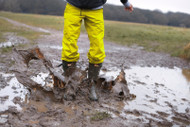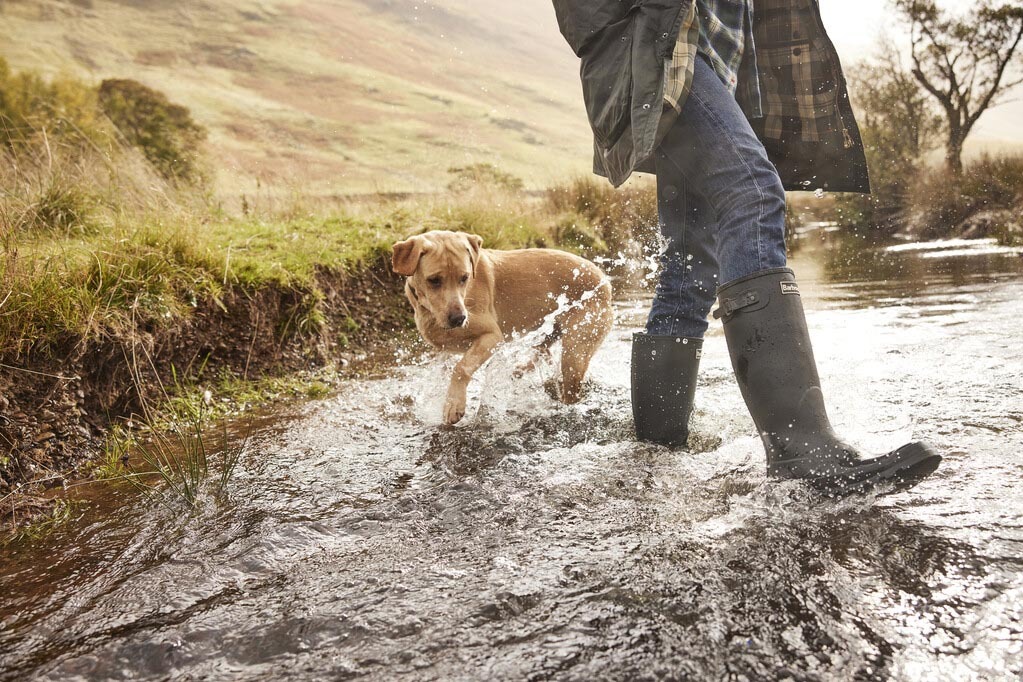5 Steps to clean rubber boots
Cleaning Your Wellies Or Rubber Boots
I think we can all agree that the whole point of wellies is for them to get muddy! But regular cleaning is needed not only to keep them looking and smelling good but also to prolong the life of your wellies and prevent issues such as cracking. During our time here at Philip Morris, one of the biggest questions we get is "how to clean hunter wellies" as well as other popular brands. So to help you keep your wellington boots in top condition, we’ve created a simple yet effective guide on how to clean both the outside and inside of your wellies at home.
How to Clean Wellies
It’s a good idea to rinse down your wellies after each use to get the worst of the mud and muck off. But now and then a more detailed approach is needed to bring them back to their best.
Step 1: Brush off
With a medium bristle brush, brush off any dried-on mud from the boots including any that is trapped in the treads. Then, with a damp rag or cloth, wipe down the boot all over to remove any residual dirt.
Step 2: Wash down
Using a mild solution of washing up liquid or baking soda and warm water, wipe the boots all over using a damp cloth. Avoid using harsh chemicals, strong detergents or extremely hot water as this may damage the rubber. Wash the soles thoroughly as well; an old toothbrush is ideal for getting in between the treads.
Rinse off well, removing any soapy water or residue, and leave to dry naturally in a well-ventilated area. Avoid direct sunlight or using heat such as radiators or hairdryers as this can cause the rubber to crack or discolour.
Step 3: Buffing spray
With natural rubber wellies, buffer spray can hugely increase the lifespan of your rubber rain boots. Sometimes rubber wellington boots develop a white film or powder known as blooming. This does not affect the performance or durability of the boot and is in fact a sign of good quality natural rubber, but it might not look particularly attractive!
The above cleaning process can normally remove blooming, but you may wish to try a dedicated boot buffer spray such as Aigle Swipol Boot Spray. These specially formulated sprays condition the rubber with natural oils to help keep it supple and get your boots looking box fresh. Simply apply the conditioner to clean and dry boots and polish them in a circular motion with a soft cloth. Again, leave your boots to dry naturally in a well-ventilated area.
Step 4: Cleaning the insides
If your boots have a jersey or polyester lining, you can give the insides a freshen-up by using a similar method to the outsides. Wipe the interior down with a mild solution of dish soap and warm water. Wipe off the soapy residue with plain water and leave the boots to dry naturally. Stuffing with scrunched-up old newspaper can help the drying process.
Step 5: Remove odours
Should your wellies get a bit whiffy, a spray made with natural white vinegar can bring them back to smelling fresh. Simply create a 50:50 solution of water and white vinegar and put it into a spray bottle. Mist the inside of your boots and leave them to dry thoroughly before wearing them. Note this should not be done if you have leather-lined wellies as it may mark the leather.
Can You Put Wellies In The Washing Machine?
As tempting as it may be, we do not recommend putting your wellies in the washing machine, ever! The heat and motion of the washing machine cycle can cause permanent damage to the natural rubber or plastic outer of your boots. The same applies to the tumble drier.
A quick spin in the machine may seem like an easy solution to clean your dirty wellies but they really are best cleaned by hand and left to dry naturally. A little bit of effort will keep your wellies looking great and performing at their best.
Drying Your Welly Boots
While it may be tempting to dry your wellies near a radiator or pop them by the fire, this can cause unnecessary damage to the mould of your boot and cause the rubber to crack, split or deform. It should also go without saying that you should never put your wellies in the tumble dryer.
The best way to ensure that your rubber boots dry correctly is to store them in a dry, warm and well-ventilated room. To speed up to process you can pat them down gently with a dry cloth and stuff the inside with newspaper to help them keep their shape.
Keeping your wellies in top condition should be a breeze if you follow our easy steps. If looked after correctly, your wellington boots should last you up to 2-3 years before we recommend replacing them.
Looking to replace or invest in a good pair of Wellington Boots and don't know where to start? Head to our blog and have a look at Our Welly Guide for some tips and inspiration on choosing the best wellington boots for you.

Posted by Abi
Abi is a web content specialist and brand manager at Philip Morris & Son, where she plays a key role in shaping the success of a diverse range of core brands, including Ariat, Alan Paine, Brabantia, Blundstone, Dubarry, and Lazy Jacks. With over 10 years of experience in the clothing retail sector, Abi joined the company in 2022, and her creativity and keen attention to detail are instrumental in enhancing product pages and optimising SEO strategies to drive brand visibility and growth.
Growing up surrounded by the Herefordshire countryside, Abi's love for the outdoors informs her understanding of the products that resonate with our customers. Her enjoyment of outdoor activities including camping and hiking gives her first-hand knowledge of how the right gear can enhance outdoor experiences. This personal insight enables her to expertly curate products that meet the needs of fellow outdoor enthusiasts. Outside of work, Abi also enjoys live music, is a keen cook and yoga enthusiast, and has recently taken up running (again!).





